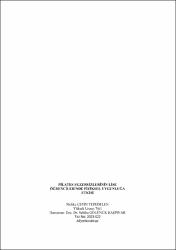Pilates egzersizlerinin lise öğrencilerinde fiziksel uygunluğa etkisi
Özet
Bu araştırmada ‘pilates egzersizlerinin lise öğrencilerinde fiziksel uygunluğa etkisi’ incelenmiştir. Çalışmaya öğrenci yurdunda yatılı olarak kalan 13-17 yaşlarında sedanter yaşam süren öğrenciler dahil edilmiştir. Araştırma öncesi etik kurul, kurum izinleri ve gönüllü onam formu alınmıştır. Katılımcı öğrenciler rastgele yöntemle uygulama grubu (UG) 25 ve kontrol grubu (KG) 36 olmak üzere toplam 61 kadından oluşturulmuştur. Çalışmada UG ortalama yaş 14,76±1,32 yıl, boy 159,52±4,87 cm, vücut ağırlığı 56,43±12,62 kg; KG ortalama yaş 15,58±1,43 yıl, boy 160,97±4,46 cm, vücut ağırlığı 58,10±10,03 kg’dır. Araştırmada deneysel araştırma türlerinden ön test - son test modeli kullanılmıştır. Her iki grubun çalışma öncesi ve sonrası vücut kompozisyon ölçümleri, vücut yağ oranları (VYO), vücut kitle indeksleri (VKİ) ve bel-kalça oranları, esneklik, kas kuvveti, kas dayanıklılık ve postür analiz ölçümleri alınmıştır. Araştırma sürecinde UG’na 8 hafta boyunca haftada 2 gün, 1 saat mat pilates egzersizleri uygulatılırken KG günlük rutin yaşantısına devam etmiştir. Verilerin analizinde farklılığın belirlenmesi için tekrarlı ölçüm ANOVA testi kullanılmıştır. Anlamlılık düzeyi p<0,05 olarak alınmıştır. Araştırma sonucunda KG ve UG ön testleri arasında anlamlı farklılık gözlenmemiştir (p>0,05). UG bacak kuvveti, sırt kuvveti, mekik, şınav ölçümleri ve postür analizi değerlerinde KG’na göre anlamlı farklılık gözlenmiştir (p<0,01). UG’nun ön-son test ölçümlerinde bacak kuvveti, sırt kuvveti, mekik, şınav ve vücut postür analizi değerlerinde anlamlı farklılık gözlenmiştir (p<0,01). Esneklik ölçümünde anlamlı farklılık görülmese de (p=0,05) ortalama değerinin arttığı gözlenmiştir.
Sonuç olarak pilates egzersizlerinin fiziksel uygunluk unsurlarından kuvvet, dayanıklık ve vücut postürü üzerinde etkili olduğu gözlenmiştir. Bu nedenle pilates egzersizlerinin bazı fiziksel uygunluk unsurları ve vücut postürünün gelişimi için kullanılmasını önermekteyiz. In this study, 'the effect of pilates exercises on physical fitness in high school students' was examined. Students aged 13-17 living in a dormitory and living a sedentary life were included in the study. Ethics committee, institutional permissions and voluntary consent forms were obtained before the study. Participating students were randomly selected from a total of 61 women, 25 in the exercise group (UG) and 36 in the control group (KG). In the study, mean age of UG was 14.76±1.32 years, height 159.52±4.87 cm, body weight 56.43±12.62 kg; KG mean age was 15.58±1.43 years, height 160.97±4.46 cm, body weight 58.10±10.03 kg. In the research, the pretest-posttest model, which is one of the experimental research types, was used. Body composition measurements, body fat ratios (BMI), body mass indexes (BMI) and waist-hip ratios, flexibility, muscle strength, muscle endurance and posture analysis measurements were taken from both groups before and after the study. During the research process, while UG was given mat pilates exercises for 1 hour, 2 days a week for 8 weeks, KG continued their daily routine. In the analysis of the data, the repeated measure ANOVA test was used to determine the difference. The significance level was taken as p<0.05. As a result of the research, no significant difference was observed between the KG and UG pretests (p>0.05). There was a significant difference in UG leg strength, back strength, sit-up, push-up measurements and posture analysis values compared to KG (p<0.01). In the pre-post test measurements of the UG, significant differences were observed in the leg strength, back strength, sit-ups, push-ups and body posture analysis values (p<0.01). Although no significant difference was observed in the flexibility measurement (p=0.05), it was observed that the mean value increased.
As a result, it has been observed that pilates exercises are effective on strength, endurance and body posture, which are physical fitness elements. For this reason, we recommend that pilates exercises be used for some physical fitness elements and the development of body posture.
Bağlantı
https://hdl.handle.net/11630/10309Koleksiyonlar
- Yüksek Lisans Tezleri [667]



















